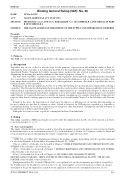Page 527 - Juta's Indirect Tax
P. 527
BGR 026
DATE: ACT : SECTION:
SUBJECT:
Preamble
VALUE-ADDED TAX ACT: BinDing gEnErAL rULingS BGR 026 Binding General Ruling (VAT): No. 26
12 March 2015
VALUE-ADDED TAX ACT 89 OF 1991
SECTIONS 11 (1) (j) AND 13(3), PARAGRAPH 7 (a) OF SCHEDULE 1 AND ITEM 12 IN PART B OF SCHEDULE 2
THE VALUE-ADDED TAX TREATMENT OF THE SUPPLY AND IMPORTATION OF HERBS
For purposes of this ruling –
• ‘BGR’ means a binding general ruling issued under section 89 of the Tax Administration Act 28 of 2011; and • ‘Item 12’ means Item 12 in Part B of Schedule 2 to the VAT Act.
• ‘section’ means a section of the VAT Act;
• ‘VAT’ means value-added tax;
• ‘VAT Act’ means the Value-Added Tax Act 89 of 1991; and
• any other word or expression bears the meaning ascribed to it in the VAT Act.
1. Purpose
This BGR sets out the VAT treatment applicable to the supply and importation of herbs.
2. Background
Vegetables that are not cooked or treated except for the purposes of preservation fall within the ambit of Item 12. Although the term ‘vegetable’ is not de ned in the VAT Act, the Agricultural Product Standards Act 119 of 1990 (the Agricultural Product Standards Act) which, amongst others, regulates the sale of fresh vegetables is of assistance in determining the meaning that must be attributed to this term for purposes of Item 12.
The term ‘fresh vegetables’ is de ned in section 1 of the regulation* issued under the Agricultural Product Standards Act, to mean those vegetables and herbs speci cally mentioned in the de nition as well as ‘unspeci ed vegetables’. The term ‘unspeci ed vegetables’ is de ned in section 1 of the regulation to mean any other kind of vegetables that are not mentioned under ‘fresh vegetables’.
Furthermore, the Customs and Excise Act No. 91 of 1964 (the Customs Act) speci cally lists culinary herbs as being a vegetable.† The Customs Act distinguishes between herbs that can be used for culinary purposes and herbs to be used for other medicinal or perfumery purposes. Herbs used for culinary purposes are classi ed under Chapter 7‡ whereas herbs imported to be used primarily in perfumery, in pharmacy or for insecticidal, fungicidal or similar purposes are classi ed under Chapter 12.§ Any herb that may be suitable for human consumption (for example, fresh basil), if imported for purposes other than for culinary purposes is not classi ed as a vegetable under Chapter 7 of the Schedule to the Customs Act.
In light of the above, the importation of a herb may be subject to a different rate of customs duty depending on the use to which it is put (that is, culinary or other). A herb is, however, for VAT purposes, regarded as a vegetable as contemplated in Item 12 even if the recipient uses it for purposes other than human consumption (the VAT treatment of the importation of herbs is dealt with under 3.3).
Taking the above into account, vegetables contemplated in Item 12 include herbs.
3. Ruling
This ruling constitutes a BGR issued under section 89 of the Tax Administration Act No. 28 of 2011 insofar as it relates to the items listed in 3.1 to 3.3.
3.1 Zero-rated supplies
The supply of herbs that have not been cooked or treated in any manner except for the purpose of preserving such herbs in their natural state, is zero-rated under section 11(1)(j) read with Item 12. Section 11(3) requires a vendor to obtain and retain documentary proof substantiating the vendor’s entitlement to apply the zero rate.¶
* GNR. 364 of 24 May 2013: Regulations relating to the grading, packing and marking of fresh vegetables intended for sale in the Republic of South Africa (Government Gazette No. 36480).
† Note 2 to Part 1 of Schedule 1 in Section II of Chapter 7: EDIBLE VEGETABLES AND CERTAIN ROOTS AND TUBERS of the Schedule to the Customs Act.
‡ Part 1 of Schedule 1 in Section II of Chapter 7: EDIBLE VEGETABLES AND CERTAIN ROOTS AND TUBERS of the Schedule to the Customs Act.
§ Part 1 of Schedule 1 in Section II of Chapter 12: OIL SEEDS AND OLEAGINOUS FRUITS; MISCELLANEOUS GRAINS, SEEDS AND FRUIT; INDUSTRIAL OR MEDICINAL PLANTS; STRAW AND FODDER of the Schedule to the Customs Act.
¶ Interpretation Note No. 31 dated 22 March 2013 (or as updated) sets out the documentary proof that is acceptable to the Commissioner for the purposes of section 11(3). A copy of the supplier’s zero-rated tax invoice setting out a proper description of the goods supplied is acceptable for the application of the zero rate contemplated in section 11(1)(j).
Juta’s IndIrect tax 2016 519


